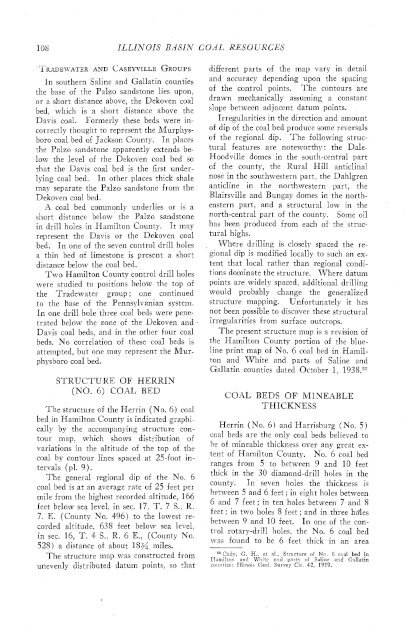subsurface geology and coal resources of the pennsylvanian system ...
subsurface geology and coal resources of the pennsylvanian system ...
subsurface geology and coal resources of the pennsylvanian system ...
Create successful ePaper yourself
Turn your PDF publications into a flip-book with our unique Google optimized e-Paper software.
108 ILLINOIS BASIN COAL RESOURCES<br />
In sou<strong>the</strong>rn Saline <strong>and</strong> Gallatin counties<br />
<strong>the</strong> base <strong>of</strong> <strong>the</strong> Palzo s<strong>and</strong>stone lies upon,<br />
or a short distance above, <strong>the</strong> Dekoven <strong>coal</strong><br />
bed, which is a short distance above <strong>the</strong><br />
Davis <strong>coal</strong>. Formerly <strong>the</strong>se beds were incorrectly<br />
thought to represent <strong>the</strong> Murphysboro<br />
<strong>coal</strong> bed <strong>of</strong> Jackson County. In places<br />
<strong>the</strong> Palzo s<strong>and</strong>stone apparently extends below<br />
<strong>the</strong> level <strong>of</strong> <strong>the</strong> Dekoven <strong>coal</strong> bed so<br />
that <strong>the</strong> Oavis <strong>coal</strong> bed is <strong>the</strong> first underlying<br />
<strong>coal</strong> bed. In o<strong>the</strong>r places thick shale<br />
may separate <strong>the</strong> Palm s<strong>and</strong>stone from <strong>the</strong><br />
Dekoven <strong>coal</strong> bed.<br />
A <strong>coal</strong> bed commonly underlies or is a<br />
short distance below <strong>the</strong> Palzo s<strong>and</strong>stone<br />
in drill holes in Hamilton County. It map<br />
represent <strong>the</strong> Davis or <strong>the</strong> Dekoven <strong>coal</strong><br />
bed. In one <strong>of</strong> <strong>the</strong> seven control drill holes<br />
a thin bed <strong>of</strong> limestone is present a short<br />
distance below <strong>the</strong> <strong>coal</strong> bed.<br />
Two Hamilton County coatrol drill holes<br />
were studied to positions below <strong>the</strong> top <strong>of</strong><br />
<strong>the</strong> Tradewater group ; one continued<br />
to <strong>the</strong> base <strong>of</strong> <strong>the</strong> Pennsylvanian <strong>system</strong>.<br />
In one drill hole three <strong>coal</strong> beds were penetrated<br />
below <strong>the</strong> zone <strong>of</strong> <strong>the</strong> Dekoven <strong>and</strong><br />
Davis <strong>coal</strong> beds, <strong>and</strong> in <strong>the</strong> o'<strong>the</strong>r four <strong>coal</strong><br />
beds. No correlation <strong>of</strong> <strong>the</strong>se <strong>coal</strong> beds is<br />
attempted, but one map represent <strong>the</strong> Murphysboro<br />
<strong>coal</strong> bed.<br />
STRUCTURE OF HERRIN<br />
(NO. 6) COAL BED<br />
The structure <strong>of</strong> <strong>the</strong> Herrin (No. 6) <strong>coal</strong><br />
bed in Hamilton County is indicated graphically<br />
by <strong>the</strong> accompanying structure contour<br />
map, which shows distribution <strong>of</strong><br />
variations in <strong>the</strong> altitude <strong>of</strong> <strong>the</strong> top <strong>of</strong> <strong>the</strong><br />
<strong>coal</strong> by contour lines spaced at 25-foot intervals<br />
(pl. 9).<br />
The general regional dip <strong>of</strong> <strong>the</strong> No. 6<br />
<strong>coal</strong> bed is at an average sate 03 25 feet per<br />
mile fl-on1 <strong>the</strong> highest recorded altitude, 166<br />
feet below sea level, in sec. 17, T. 7 S., R.<br />
7. E. (County No. 496) to <strong>the</strong> lowest recorded<br />
altitude, 638 feet below sea level,<br />
in sec. 16, T. 4 S., R. 6 E., (County No.<br />
528) a distance <strong>of</strong> about 18% miles.<br />
The structure map m7as constructed from<br />
unevenly distributed datum points, so that<br />
different parts <strong>of</strong> <strong>the</strong> map vary in detail<br />
<strong>and</strong> accuracy depending upon <strong>the</strong> spacing<br />
<strong>of</strong> <strong>the</strong> control points. The contours are<br />
drawn mechanically assuming a constant<br />
slope between adjacent datum points.<br />
Irregularities in <strong>the</strong> direction <strong>and</strong> amount<br />
<strong>of</strong> dip <strong>of</strong> <strong>the</strong> <strong>coal</strong> bed produce some reversals<br />
<strong>of</strong> <strong>the</strong> regional dip. The following structural<br />
features are noteworthy: <strong>the</strong> Dale-<br />
Hoodville domes in <strong>the</strong> south-central part<br />
<strong>of</strong> <strong>the</strong> county, <strong>the</strong> Rural Hill anticlinal<br />
nose in <strong>the</strong> southwestern part, <strong>the</strong> Dahlgren<br />
anticline in <strong>the</strong> northwestern part, <strong>the</strong><br />
Blairsville <strong>and</strong> Bungay domes in <strong>the</strong> nor<strong>the</strong>astern<br />
part, <strong>and</strong> a structural low in <strong>the</strong><br />
north-central part <strong>of</strong> <strong>the</strong> county. Some oil<br />
has been produced from each <strong>of</strong> <strong>the</strong> structural<br />
highs.<br />
Where drilling is closely spaced <strong>the</strong> regional<br />
dip is modified locally to such an extent<br />
that local ra<strong>the</strong>r than regional conditiom<br />
dominate <strong>the</strong> structure. Where datum<br />
points are widely spaced, additional drilling<br />
would probably change <strong>the</strong> generalized<br />
structure mapping. Unfortunately it has<br />
not been possible to discover <strong>the</strong>se structural<br />
irregularities from surface outcrops.<br />
The present structure map is a revision <strong>of</strong><br />
<strong>the</strong> Hamilton County portion <strong>of</strong> <strong>the</strong> blueline<br />
print map <strong>of</strong> No. 6 <strong>coal</strong> bed in Hamilton<br />
<strong>and</strong> White <strong>and</strong> parts <strong>of</strong> Saline <strong>and</strong><br />
Gallatin counties dated October 1, 1938.22<br />
COAL BEDS OF MINEABLE<br />
THICKNESS<br />
Herrin (No. 6) <strong>and</strong> Harrisburg (No. 5)<br />
ccal beds are <strong>the</strong> only <strong>coal</strong> beds believed to<br />
be <strong>of</strong> mineable thickness over any great extent<br />
<strong>of</strong> Hamilton County. No. 6 <strong>coal</strong> bed<br />
r2nges from 5 to between 9 <strong>and</strong> 10 feet<br />
thick in <strong>the</strong> 30 diamond-drill holes in <strong>the</strong><br />
county. In seven holes <strong>the</strong> thickness is<br />
hetween 5 <strong>and</strong> 6 feet; in eight holes between<br />
6 <strong>and</strong> 7 feet; in ten holes between 7 <strong>and</strong> 8<br />
feet; in two ho'les 8 feet ; <strong>and</strong> in three hdes<br />
between 9 <strong>and</strong> 10 feet. In one <strong>of</strong> <strong>the</strong> control<br />
rotary-drill holes, <strong>the</strong> No. 6 <strong>coal</strong> bed<br />
was found to be 6 feet thick in an area<br />
'Tacly, G. H.. et al., Structure <strong>of</strong> No. 6 <strong>coal</strong> bed in<br />
I-Iamilton <strong>and</strong> White <strong>and</strong> parts <strong>of</strong> Saline <strong>and</strong> Gallatin<br />
colintic~: Illinois Geol. Survey Cir. 42, 1939.
















